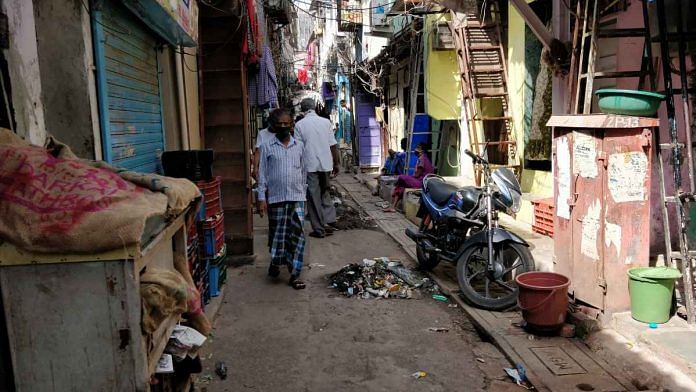New Delhi: From spending a fortnight in a quarantine facility to witnessing the cycle of life and death, ThePrint’s reporters have, for several weeks now, been travelling across the length and breadth of India on the coronavirus trail.
They travelled across Madhya Pradesh, Rajasthan, Gujarat, Maharashtra and Bihar to find out, first-hand, how the pandemic and the lockdown have impacted, and continue to impact, people from all over the country.
ThePrint’s reporters and photojournalists spoke to the labourers walking on the highways of Rajasthan and even spent time in Mumbai’s Dharavi — Asia’s biggest slum and now a Covid hotspot.
They watched a son cremate his father who died just 30 km from home in Uttar Pradesh and transported a woman to the hospital when she went into labour in Gopalganj, near the UP-Bihar border.
Some of them even tested positive for Covid-19 themselves.
A tale of quarantine
Journalist Simrin Sirur and photojournalist Praveen Jain had already covered 3,000 km across Rajasthan and Gujarat when, on 27 April, Praveen and their driver Anil, began to feel unwell.
The next day, the three went to a testing camp for journalists where all of them ended up testing positive for the virus.
While Simrin remained largely asymptomatic, Praveen and Anil, both in their 50s, showed some symptoms. Spending the next two weeks in a quarantine facility in Vadodara, Praveen and Simrin found a unique opportunity to document their stay, their treatment, their meals and even the stories of other patients. Read more about their experiences at the quarantine facility here.
Also read: People in my UP village don’t want to go to ‘bade shahar’ any more
Inside the Covid hotspot Dharavi
In Mumbai, Swagata Yadavar and Soniya Agrawal spent some time in Dharavi, the massive slum area that has reported over 1,500 cases of Covid-19 and more than 50 deaths. The 2.4 sq km area is home to roughly 8.5 lakh people and several thousands of them share one toilet, making social distancing and sanitation impossible.
Swagata and Soniya met several residents of Dharavi who were unimpressed with the authorities’ efforts to contain the spread of infection, and were equally worried about how the stigma of living in a hotspot would affect their chances of getting work.
Social worker and Dharavi resident Mashook Ali Khan said that while local politicians had set up community kitchens, they were only interested in serving people from their community.
From the filthy, sewage-water-choked lanes of Dharavi, Soniya and Swagata returned to their hotel, sanitised their equipment and washed up before settling in for dinner, one of the only two meals that the hotel provides. They were lucky, they say, given the hardships they witnessed, not only in Mumbai, but also in Surat and across Rajasthan.
Soniya recalls two women on the outskirts of Rajasthan’s Kishangarh, who looked like they hadn’t eaten in days. They devoured the biscuits that Soniya and Swagata gave them, and kept repeating “hum toh gareeb hai na” (it’s because we are poor) as if to justify the misery they were going through. Read more about Soniya and Swagata’s travels here and here.
Also read: Warmth, food, lots of chai — 2 journalists on Covid-19 trail get taste of Punjabi kindness
Witnessing the circle of life and death
Travelling across Uttar Pradesh and Bihar, Bismee Taskin and Jyoti Yadav found that ‘reverse migration’, labourers returning from the big cities to their villages, was actually creating an economic burden for the women of their families.
They visited three villages in Sitamarhi district where local women told them that they had to arrange money for their sons and husbands, who had gone to cities to work, to ensure they can return home. Apart from the problem of money lenders setting a debilitatingly high interest rate, there is, as some of the village leaders said, the fear of a rise in domestic violence.
The journalists’ journey has been a major learning curve, said Bismee, given their relatively comfortable life so far, even during the pandemic. Two incidents, in particular, stood out for the two reporters. The death of a worker who travelled for four days in trucks from Mumbai only to die 30 km from his home in UP’s Sant Kabir Nagar. He was found to be Covid-positive, and his family had to be quarantined immediately after the cremation.
Three days later, in Gopalganj, near the UP-Bihar border, they witnessed a new life come into the world, when a woman at the transit centre went into labour. Bismee and Jyoti managed to arrange an ambulance for her, and Jyoti was there, at the hospital, when the baby was born.
The bittersweet emotions of witnessing the circle of life and death in such rapid motion is something they will never forget. Read more about their travels here and here.
Also read: From death to life in 72 hours — my 10 days on the road covering Covid through UP, Bihar



